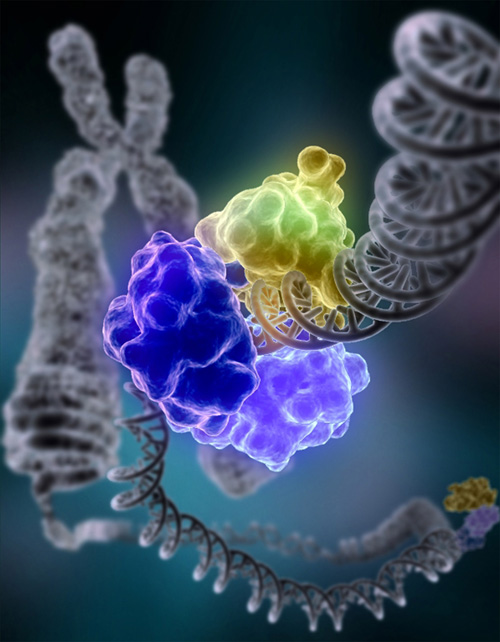Oxygen poor, hypoxic tissue promotes a cellular shift in mitochondrial metabolism from OXPHOS to less energy efficient glycolysis. Each shift induces environmental, epigenetic and genetic factors that alter a cells response to insult, attack and disease. Endothelial tip cells at micro-vessel ends are predominantly glycolytic. However, deletion of
PFKFB3, the critical regulator of glycolysis reduced the sprouting of micro-vessel tips and elevated PFKFB3 levels improved tip cell sprouting, direction and cell behavior.
In response to DNA damage p53 promotes nucleotide biosynthesis by repressing the expression of PFKFB3. This increases the flux of glucose, through the pentose phosphate pathway (PPP) to increase nucleotide production, which results in more efficient repair of DNA damage and cell survival.
In Panc1 pancreatic cells, pro-apoptotic TGFβ1 enhanced PFKFB3 expression and stimulated glycolysis. Extracellular lactate induces endothelial mesenchymal transition (EMT) by remodeling the extracellular matrix and releasing activated TGFβ1. TGFβ is a potent immunosuppressive cytokine that can impede development and function of natural killer (NK) and other immune cells. Furthermore, high extracellular lactate levels can contribute to immune evasion, thereby promoting tumor growth and metastasis. In tumor microenvironments glycolysis also leads to accumulated lactate, which stabilizes hypoxia inducible factor 1α (HIF-1) and upregulates the expression of anti-apoptotic, VEGF (in axis with NRP-1 dependency) resulting in angiogenesis and stimulation of cell migration.
Hypoxia induces the loss of differentiation markers of several tumor types while increasing expression of embryonic markers such as transcription factors NANOG, OCT4, SOX2, and the Notch ligand. This reprogramming, toward a cancer stem phenotype is associated with increased tumorigenesis. In non-small cell lung carcinoma cells hypoxia increased NANOG expression that contributed to hypoxia-induced tumor cell resistance against cytotoxic lymphocyte (CTL)-mediated lysis.
Under stress the outer mitochondrial membrane incorporates Pink1, which binds and phosphorylates p53 at serine 392 and aids phagophore formation to enhance mitophagy. This reduces transport of p53-s392 to the nucleus where it would otherwise disrupt transcription of Nanog. p53 regulates Pink1 and Parkin, which regulate mitochondrial antigen presentation of both MHC classes.
The development of type 1 diabetes involves a complex interaction between pancreatic β-cells and cells of the innate and adaptive immune systems. Analyses of the interactions between NK cells, NKT cells, dendritic cell populations and T cells have highlighted how these can influence the onset of autoimmunity. NK cells were observed in the pancreas, in NoD mice before T cell infiltration and are critically required in the pancreas for accelerated diabetes.
The islet in type 2 diabetes (T2D) is characterized by IAPP amyloid deposits, a protein co-expressed with insulin by β-cells. Human IAPP (hIAPP) misfolded protein stress  activates HIF-1/PFKFB3 signaling, which increases glycolysis, mitochondrial fragmentation and perinuclear clustering, considered protective against increased cytosolic Ca2+, characteristic of amylin toxic oligomer stress. β-cells in adult humans are minimally replicative and fail to execute the second pro-regenerative phase of the HIF-1/PFKFB3 injury pathway. β-cells remain trapped in the pro-survival first phase of the HIF-1 injury repair response with a metabolism and mitochondrial network adapted to slow the rate of cell attrition at the expense of β-cell function. The senescent-like state may support the reduced NK cell activity and presence of more pro-inflammatory M1 macrophages in T2D
activates HIF-1/PFKFB3 signaling, which increases glycolysis, mitochondrial fragmentation and perinuclear clustering, considered protective against increased cytosolic Ca2+, characteristic of amylin toxic oligomer stress. β-cells in adult humans are minimally replicative and fail to execute the second pro-regenerative phase of the HIF-1/PFKFB3 injury pathway. β-cells remain trapped in the pro-survival first phase of the HIF-1 injury repair response with a metabolism and mitochondrial network adapted to slow the rate of cell attrition at the expense of β-cell function. The senescent-like state may support the reduced NK cell activity and presence of more pro-inflammatory M1 macrophages in T2D
p53 deficient tumors can be metabolically reprogrammed and regressed by deleting isoforms of p63 or p73 to upregulate IAPP and amylin, which through the calcitonin receptor (CalcR) and receptor-activity-modifying-protein 3 (RAMP3) inhibit glycolysis, induce ROS and apoptosis. In epidermal keratinocytes p63 promotes glycolytic metabolism by binding PFKFB3 consensus sites required for mRNA and protein expression.
Senescent cells typically upregulate anti-apoptotic pathways, and are preferentially susceptible to inhibition of these pro-survival mechanisms. This has been dubbed the ‘Achilles heel’ of senescent cells and may relate to the low mitochondrial membrane potential found in many senescent cells that ease the release of apoptosis-stimulating factors from mitochondria to promote survival. Similar weaknesses may be present through glycolysis in cancer, diabetes, other diseases and immune response.







